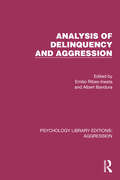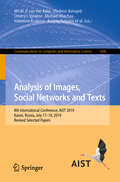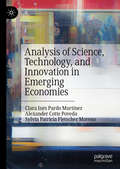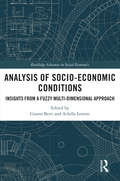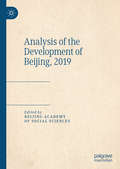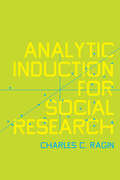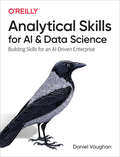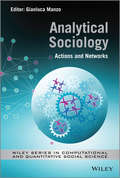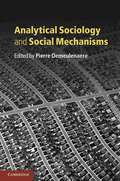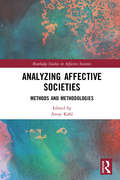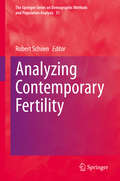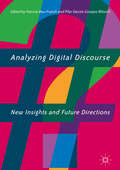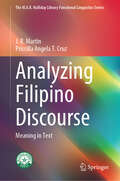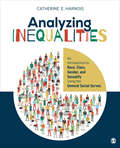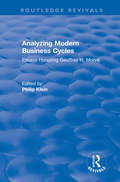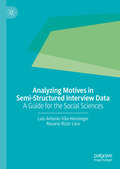- Table View
- List View
Analysis of Delinquency and Aggression (Psychology Library Editions: Aggression)
by Albert Bandura Emilio Ribes-InestaOriginally published in 1976, this volume is organized about two central themes: the experimental analysis of aggression, and the application of learning principles to the prevention and modification of delinquency. The chapters, all new and original at the time, demonstrate how the problems of aggression, which had been interpreted in diverse ways, can be analyzed under controlled laboratory conditions. In addition, the contributors offer an explanation of how behavior modification techniques, derived from this knowledge, can be used for preventive purposes.Because of the social nature of aggression and delinquency, behavior change techniques were principally aimed at modifying environmental influences. The contributions to this volume illustrate how behavioral scientists may aid in the understanding and amelioration of conditions that give rise to violence. Today it can be read and enjoyed in its historical context.
Analysis of Images, Social Networks and Texts: 8th International Conference, AIST 2019, Kazan, Russia, July 17–19, 2019, Revised Selected Papers (Communications in Computer and Information Science #1086)
by Vladimir Batagelj Panos M. Pardalos Andrey V. Savchenko Dmitry I. Ignatov Wil M. P. van der Aalst Marcello Pelillo Michael Khachay Natalia Loukachevitch Sergei O. Kuznetsov Irina A. Lomazova Amedeo Napoli Valentina Kuskova Andrey Kutuzov Elena TutubalinaThis book constitutes the proceedings of the 8th International Conference on Analysis of Images, Social Networks and Texts, AIST 2019, held in Kazan, Russia, in July 2019.The 24 full papers and 10 short papers were carefully reviewed and selected from 134 submissions (of which 21 papers were rejected without being reviewed). The papers are organized in topical sections on general topics of data analysis; natural language processing; social network analysis; analysis of images and video; optimization problems on graphs and network structures; analysis of dynamic behaviour through event data.
Analysis of Science, Technology, and Innovation in Emerging Economies
by Clara Inés Pardo Martínez Alexander Cotte Poveda Sylvia Patricia Fletscher MorenoThis book outlines a number of different perspectives on the relationship between science, technology, and innovation in emerging economies. In it, the authors explore the aforementioned relationship as a pillar of economic development, driving growth in emerging economies. Employing a collaborative and interdisciplinary approach, the authors work to determine the main related factors and outcomes of the relationship between science, technology, and innovation, ultimately seeking to guide public policies to enhance the welfare of the population of an emerging economy.
Analysis of Socio-Economic Conditions: Insights from a Fuzzy Multi-dimensional Approach (Routledge Advances in Social Economics)
by Gianni Betti and Achille LemmiShowcasing fuzzy set theory, this book highlights the enormous potential of fuzzy logic in helping to analyse the complexity of a wide range of socio-economic patterns and behaviour. The contributions to this volume explore the most up-to-date fuzzy-set methods for the measurement of socio-economic phenomena in a multidimensional and/or dynamic perspective. Thus far, fuzzy-set theory has primarily been utilised in the social sciences in the field of poverty measurement. These chapters examine the latest work in this area, while also exploring further applications including social exclusion, the labour market, educational mismatch, sustainability, quality of life and violence against women. The authors demonstrate that real-world situations are often characterised by imprecision, uncertainty and vagueness, which cannot be properly described by the classical set theory which uses a simple true–false binary logic. By contrast, fuzzy-set theory has been shown to be a powerful tool for describing the multidimensionality and complexity of social phenomena. This book will be of significant interest to economists, statisticians and sociologists utilising quantitative methods to explore socio-economic phenomena.
Analysis of the Development of Beijing, 2019
by Beijing Academy of Social SciencesThis book provides an overview of the rapid development Beijing has seen in a wide range of areas in 2018, both in itself and as an integral part of a larger region, as China’s economic development continues to improve in overall quality and regional coordination. General reports on progress Beijing made and problems it faced in 2018 in improving its economy, public services, and municipal and community governance, urban planning, and funding for innovations are followed by case studies that look at best practices and how they can be applied towards promoting coordinated development of the Beijing-Tianjin-Hebei region. The strategy features prominently in the outlook contributors present for the greater metropolitan area of Beijing for 2019.This book is a valuable source of reference for anyone trying to gain a better understanding the what, how, and why in relation to one of the world’s fastest growing mega-cities.
Analytic Induction for Social Research
by Charles C. RaginA free ebook version of this title is available through Luminos, University of California Press’s Open Access publishing program. Visit www.luminosoa.org to learn more. This book explores analytic induction, an approach to the analysis of cross-case evidence on qualitative outcomes that has deep roots in sociology. A popular research technique in the early decades of empirical sociology, analytic induction differs fundamentally as a method of social research from conventional variation-based approaches. In Analytic Induction for Social Research, Charles C. Ragin demonstrates that much is gained from systematizing analytic induction. The approach he introduces here offers a new template for conducting cross-case analysis and provides a new set of tools for answering common research questions that existing methods cannot address.
Analytical Skills for AI and Data Science: Building Skills for an AI-Driven Enterprise
by Daniel VaughanWhile several market-leading companies have successfully transformed their business models by following data- and AI-driven paths, the vast majority have yet to reap the benefits. How can your business and analytics units gain a competitive advantage by capturing the full potential of this predictive revolution? This practical guide presents a battle-tested end-to-end method to help you translate business decisions into tractable prescriptive solutions using data and AI as fundamental inputs.Author Daniel Vaughan shows data scientists, analytics practitioners, and others interested in using AI to transform their businesses not only how to ask the right questions but also how to generate value using modern AI technologies and decision-making principles. You’ll explore several use cases common to many enterprises, complete with examples you can apply when working to solve your own issues.Break business decisions into stages that can be tackled using different skills from the analytical toolboxIdentify and embrace uncertainty in decision making and protect against common human biasesCustomize optimal decisions to different customers using predictive and prescriptive methods and technologiesAsk business questions that create high value through AI- and data-driven technologies
Analytical Sociology
by Gianluca ManzoDemonstrates the power of the theoretical framework of analytical sociology inexplaining a large array of social phenomenaAnalytical Sociology: Actions and Networks presents the most advanced theoretical discussion of analytical sociology, along with a unique set of examples on mechanism-based sociology. Leading scholars apply the theoretical principles of analytical sociology to understand how puzzling social and historical phenomena including crime, lynching, witch-hunts, tax behaviours, Web-based social movement and communication, restaurant reputation, job search and careers, social network homophily and instability, cooperation and trust are brought about by complex, multi-layered social mechanisms. The analyses presented in this book rely on a wide range of methods which include qualitative observations, advanced statistical techniques, complex network tools, refined simulation methods and creative experimental protocols. This book ultimately demonstrates that sociology, like any other science, is at its best when it dissects the mechanisms at work by means of rigorous model building and testing. Analytical Sociology: * Provides the most complete and up-to-date theoretical treatment of analytical sociology.* Looks at a wide range of complex social phenomena within a single and unitary theoretical framework.* Explores a variety of advanced methods to build and test theoretical models.* Examines how both computational modelling and experiments can be used to study the complex relation between norms, networks and social actions.* Brings together research from leading global experts in the field in order to present a unique set of examples on mechanism-based sociology.Advanced graduate students and researchers working in sociology, methodology of social sciences, statistics, social networks analysis and computer simulation will benefit from this book.
Analytical Sociology and Social Mechanisms
by Pierre DemeulenaereMechanisms are very much a part of social life. For example, we can see that inequality has tended to increase over time, and that cities can become segregated. But how do such mechanisms work? Analytical sociology is an influential approach to sociology which holds that explanations of social phenomena should focus on the social mechanisms that bring them about. This book evaluates the major features of this approach, focusing on the significance of the notion of mechanism. Leading scholars seek to answer a number of questions in order to explore all the relevant dimensions of mechanism-based explanations in social sciences. How do social mechanisms link together individual actions and social environments? What is the role of multi-agent modelling in the conceptualization of mechanisms? Does the notion of mechanism solve the problem of relevance in social sciences explanations?
Analyzing Affective Societies: Methods and Methodologies (Routledge Studies in Affective Societies)
by Antje KahlIn recent years, research in the social sciences and cultural studies has increasingly paid attention to the generative power of emotions and affects; that is, to the questions of how far they shape social and cultural processes while being simultaneously shaped by them. However, the literature on the methodological implications of researching affects and emotions remains rather limited. As a collective outcome of the Collaborative Research Center (CRC) Affective Societies at Freie Universität Berlin, Analyzing Affective Societies introduces procedures and methodologies applied by researchers of the CRC for investigating societies as affective societies. Presenting scholarly research practices by means of concrete examples and case studies, the book does not contain any conclusive methodological advice, but rather engages in illustrative descriptions of the authors’ research practices. Analyzing Affective Societies unveils different research approaches, procedures and practices of a variety of disciplines from the humanities, arts and social sciences. It will appeal to students and researchers interested in fields such as Qualitative Research Methods, Emotions, Affect, Cultural Studies and Social Sciences.
Analyzing Contemporary Fertility (The Springer Series on Demographic Methods and Population Analysis #51)
by Robert SchoenThis edited volume offers state-of-the-art research on the dynamics of contemporary fertility by examining the implications of the economic and social forces that are driving the rapid change in fertility behavior, and the changing context, determinants, and measurement of contemporary human reproduction. The volume explores new theoretical avenues that seek to incorporate uncertainty, examine social contagion effects, and explain the rise in childlessness. Reproductive attitudes are re-examined in chapters that deal with models of parenthood and with the persistence of race-ethnic-nativity differences. A new and important subject of multi-partner fertility is also described by examining it in the context of total fertility and from the usually neglected perspective of men. The impact of divorce on fertility, the measurement of childlessness and the postponement of first births, developments in assortative mating and fertility, and current patterns of interracial fertility are also addressed in this volume. By combining up-to-date research spanning the entire field to illuminate contemporary developments, the book is a valuable source for demographers, sociologists, economists, and all those interested in understanding fertility in today's world.
Analyzing Digital Discourse: New Insights and Future Directions
by Pilar Garcés-Conejos Blitvich Patricia Bou-FranchThis innovative edited collection presents new insights into emerging debates around digital communication practices. It brings together research by leading international experts to examine methods and approaches, multimodality, face and identity, across five thematically organised sections. Its contributors revise current paradigms in view of past, present, and future research and analyse how users deploy the wealth of multimodal resources afforded by digital technologies to undertake tasks and to enact identity. In its concluding section it identifies the ideologies that underpin the construction of digital texts in the social world. This important contribution to digital discourse studies will have interdisciplinary appeal across the fields of linguistics, socio-linguistics, pragmatics, discourse analysis, gender studies, multimodality, media and communication studies.
Analyzing Filipino Discourse: Meaning in Text (The M.A.K. Halliday Library Functional Linguistics Series)
by J. R. Martin Priscilla Angela CruzThis book explores Filipino, the national language of the Philippines, from the perspectives of Critical Discourse Analysis (CDA) and Positive Discourse Analysis (PDA)—informed by Systemic Functional Linguistics (SFL). It is designed to encourage researchers to study Filipino texts—both spoken and written—and to unpack them in a way that clarifies their function in Philippine society. With this goal in mind, the book introduces a number of discourse analysis tools and shows how to apply them to a range of Filipino texts—including a children's picture book story, some mental health advice about coping with COVID-19, President Duterte's speech about the Philippine government's initial response to the COVID-19 pandemic, a comment piece from a student newspaper about problems with online learning modules produced by the Department of Education, and a reflective text about growing up in Davao. This is the first book to draw on a range of functional linguistic tools to analyse Filipino discourse in order to provide deeper insights into the role of language in bilingual education, the linguistic enactment of power, and the importance of thinking across languages when analysing texts. Key issues addressed include the complementarity of CDA and PDA, SFL's model of social context (as register and genre), analysing bilingual texts and bilingual education. The book fosters appliable linguistics as a dialectic of theory, description, and practice—supporting Filipino discourse analysts as they engage with the challenge of giving people access to a range of tools they can use productively to mean and thereby more successfully pursue their social goals. As such, it provides a model for researchers of other languages of how to encourage the analysis of meaning in texts within and beyond the clause. It is relevant to scholars across the spectrum of linguistics, particularly those working in Systemic Functional Linguistics.
Analyzing Inequalities: An Introduction to Race, Class, Gender, and Sexuality Using the General Social Survey
by Catherine E. HarnoisAnalyzing Inequalities: An Introduction to Race, Class, Gender, and Sexuality Using the General Social Survey is a practical resource for helping students connect sociological issues with real-world data in the context of their first undergraduate sociology courses. This worktext introduces readers to the GSS, one of the most widely analyzed surveys in the U.S.; examines a range of GSS questions related to social inequalities; and demonstrates basic techniques for analyzing this data online. No special software is required–the exercises can be completed using the Survey Documentation and Analysis (SDA) website at the University of California-Berkeley which is easy to navigate and master. Students will come away with a better understanding of social science research, and will be better positioned to ask and answer the sociological questions that most interest them.
Analyzing Inequalities: An Introduction to Race, Class, Gender, and Sexuality Using the General Social Survey
by Catherine E. HarnoisAnalyzing Inequalities: An Introduction to Race, Class, Gender, and Sexuality Using the General Social Survey is a practical resource for helping students connect sociological issues with real-world data in the context of their first undergraduate sociology courses. This worktext introduces readers to the GSS, one of the most widely analyzed surveys in the U.S.; examines a range of GSS questions related to social inequalities; and demonstrates basic techniques for analyzing this data online. No special software is required–the exercises can be completed using the Survey Documentation and Analysis (SDA) website at the University of California-Berkeley which is easy to navigate and master. Students will come away with a better understanding of social science research, and will be better positioned to ask and answer the sociological questions that most interest them.
Analyzing Modern Business Cycles: Essays Honoring
by Philip A KleinThis title was first published in 1990.
Analyzing Motives in Semi-Structured Interview Data: A Guide for the Social Sciences
by Luis Antonio Vila-Henninger Rosario Rizzo LaraThis book advances the emerging work on using semi-structured interview data to analyze motives by providing the first book-length treatment of this underdeveloped methodological area in sociology and social science more broadly. Exploring key methodological and theoretical debates on this topic in-depth, the authors apply a dual-process model approach to demonstrate how we can analyze motives effectively in semi-structured interview data, and in tandem, understand the sociological reasoning behind society's moral judgments and political decision-making. Additionally, the authors develop the accessible and rigorous 5Rs methodology, which synthesizes insights from an array of literatures into a novel, cohesive analytic tool for analyzing motives in semi-structured interview data. Balancing transparency with theoretical nuance, it enables researchers to revisit and reuse previously collected data that may have been considered unsuitable for motive analysis, either because of prevailing disciplinary assumptions, or because of how data were initially framed and coded. Applicable to various cultural contexts and disciplines, the methodology explored in this book is thus of international interest to researchers and students of qualitative sociology, sociology of culture and cognition, migration studies, cognitive science, and moral psychology, with wider implications for qualitative methodologies in the social sciences.
Analyzing Music in Advertising: Television Commercials and Consumer Choice (Routledge Interpretive Marketing Research)
by Nicolai GraakjaerThe study of music in commercials is well-suited for exploring the persuasive impact that music has beyond the ability to entertain, edify, and purify its audience. This book focuses on music in commercials from an interpretive text analytical perspective, answering hitherto neglected questions: What characterizes music in commercials compared to other commercial music and other music on TV? How does music in commercials relate to music ‘outside’ the universe of commercials? How and what can music in commercials signify? Author Nicolai Graakjær sets a new benchmark for the international scholarly study of music on television and its pervading influence on consumer choice.
Analyzing Narrative: Discourse and Sociolinguistic Perspectives
by Anna De Fina Alexandra GeorgakopoulouThe socially minded linguistic study of storytelling in everyday life has been rapidly expanding. This book provides a critical engagement with this dynamic field of narrative studies, addressing long-standing questions such as definitions of narrative and views of narrative structure but also more recent preoccupations such as narrative discourse and identities, narrative language, power and ideologies. It also offers an overview of a wide range of methodologies, analytical modes and perspectives on narrative from conversation analysis to critical discourse analysis, to linguistic anthropology and ethnography of communication. The discussion engages with studies of narrative in multiple situational and cultural settings, from informal-intimate to institutional. It also demonstrates how recent trends in narrative analysis, such as small stories research, positioning analysis and sociocultural orientations, have contributed to a new paradigm that approaches narratives not simply as texts, but rather as complex communicative practices intimately linked with the production of social life.
Analyzing Organization Cultures (Routledge Studies in Management, Organizations and Society)
by Bruce FortadoCertain consultants argue leaders can quickly, easily, and considerably alter their organization cultures to improve performance. Conversely, field researchers have described situations where leaders could do little to alter the existing organization culture. Between these extreme positions, a spectrum of varying degrees of leader influence exists, and organizations fall at various places along this spectrum. This book presents five field studies dealing with team, service, and sales cultures where both expected and unexpected outcomes arose. In multiple instances, leaders hoped showing some employee appreciation would compensate for offering below market average wages. Several leadership groups were prospering based on cost cuts or increased sales. Those below often had their work intensified and they were experiencing greater stress. Eight paradoxical situations were uncovered and the interpretations of the participants were based in part on their personal work histories and the history of their current organization. In each case, evidence of employee informal organization and managerial operating cultures were documented. Analyzing Organization Cultures uses detailed case studies of five work organizations to offer a comparative approach to analyzing organizational culture. It shows the latest state of knowledge on the topic and will be of interest to researchers, academics, and students in the fields of organizational studies, management history, human resource management, and organizational theory.
Analyzing Population and Land Use Change: Selected Case Studies of Indian Metropolitan Cities (SpringerBriefs in Geography)
by Ankit Sikarwar Aparajita ChattopadhyayThis multidisciplinary book discusses and scientifically analyzes issues related to population, land use/cover (LULC) and environmental transformations in the seven most populated cities in India: Delhi, Mumbai, Kolkata, Bangalore, Chennai, Hyderabad and Ahmedabad. To do so, it closely examines and compares the trends in selected population parameters, including total population, total number of households, population density, population growth rate, percent of total population in slums and intercensal net migration over the past two decades. Presenting the changes in various LULC categories (built-up land, forest cover, agricultural land, fallow land and water bodies) using the supervised classification of Landsat TM-5 images, it assesses the impact of population and LULC on the maximum and minimum temperatures and average annual rainfall in these regions. The book is a valuable resource for researchers and academics in the areas of sustainability, population and development, and environmental studies as well as those in NGOs and humanitarian sectors working in the areas of sustainable development and environment.
Analyzing Qualitative Data
by Alan Bryman Robert G. BurgessThis major inter-disciplinary collection, edited by two of the best respected figures in the field, provides a superb general introduction to this subject. Chapters include discussions of fieldwork methodology, analyzing discourse, the advantages and pitfalls of team approaches, the uses of computers, and the applications of qualitative data analysis for social policy. Shrewd and insightful, the collection will be required reading for students of the latest thinking on research methods.
Analyzing Qualitative Data: Systematic Approaches
by Gery Ryan H. BernardThis book introduces readers to systematic methods for analyzing qualitative data. Unlike other texts, it covers the extensive range of available methods so that readers become aware of the array of techniques beyond their individual disciplines. Part I is an overview of the basics. Part II comprises 11 chapters, each treating a different method for analyzing text. Real examples from the literature across the health and social sciences provide invaluable applied understanding.
Analyzing Social Interaction: Advances in Affect Control Theory
by David R. Heise Lynn Smith-LovinFirst Published in 1988. Routledge is an imprint of Taylor & Francis, an informa company.
Analyzing Social Networks Using R
by Jeffrey C. Johnson Martin G. Everett Stephen P. Borgatti Filip AgneessensThis approachable book introduces network research in R, walking you through every step of doing social network analysis. Drawing together research design, data collection and data analysis, it explains the core concepts of network analysis in a non-technical way. The book balances an easy to follow explanation of the theoretical and statistical foundations underpinning network analysis with practical guidance on key steps like data management, preparation and visualisation. With clarity and expert insight, it: • Discusses measures and techniques for analyzing social network data, including digital media • Explains a range of statistical models including QAP and ERGM, giving you the tools to approach different types of networks • Offers digital resources like practice datasets and worked examples that help you get to grips with R software
